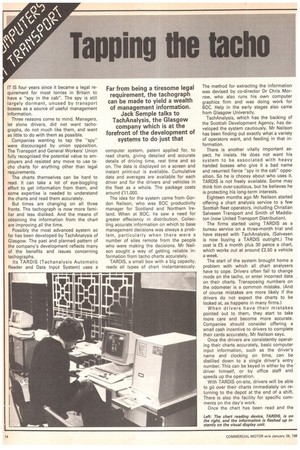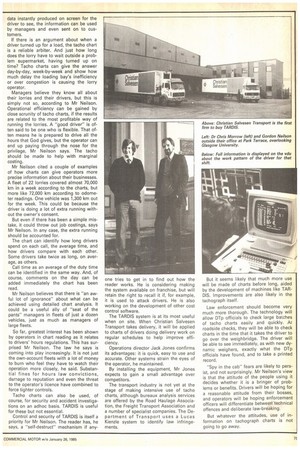Far from being a tiresome legal requirement, the tachograph can
Page 76

Page 77

If you've noticed an error in this article please click here to report it so we can fix it.
be made to yield a wealth of management information. Jack Semple talks to TachAnalysis, the Glasgow company which is at the forefront of the development of systems to do just that
IT IS four years since it became a legal requirement for most lorries in Britain to have a "spy in the cab". The spy is still largely dormant, unused by transport bosses as a source of useful management information.
Three reasons come to mind. Managers, let alone drivers, did not want tachographs, do not much like them, and want as little to do with them as possible.
Companies wanting to tap the "spy" were discouraged by union opposition. The Transport and General Workers' Union fully recognised the potential value to employers and resisted any move to use tacho charts for anything other than legal requirements.
The charts themselves can be hard to read. It can take a lot of eye-boggling effort to get information from them, and some expertise is needed to understand the charts and read them accurately.
But times are changing on all three fronts. The tachograph is now more familiar and less disliked. And the means of obtaining the information from the chart are improving all the time.
Possibly the most advanced system so far has been developed by TachAnalysis of Glasgow. The past and planned pattern of the company's development reflects many of the benefits and issues concerning tachographs.
Its TARDIS (Tachanalysis Automatic Reader and Data Input System) uses a computer system, patent applied for, to read charts, giving detailed and accurate details of driving time, rest time and so on. The data is displayed on a screen and instant print-out is available. Cumulative data and averages are available for each driver and for the drivers and vehicles in the fleet as a whole. The package costs around £11,000.
The idea for the system came from Gordon Neilson, who was BOC productivity manager for Scotland and Northern Ireland. When at BOC, he saw a need for greater effeciency in distribution. Collecting accurate information on which to base management decisions was always a problem, particularly when there were a number of sites remote from the people who were making the decisions. Mr Neilson sought a way of getting reliable information from tacho charts accurately.
TARDIS, a small box with a big capacity, reads all types of chart instantaneously. The method for extracting the information was devised by co-director Dr Chris Morrow, who also runs his own computer graphics firm and was doing work for BOC. Help in the early stages also came from Glasgow University.
TachAnalysis, which has the backing of the Scottish Development Agency, has developed the system cautiously. Mr Neilson has been finding out exactly what a variety of operators want, and feeding in that information.
There is another vitally important aspect, he insists. He does not want his system to be associated with heavy handed bosses who give it a bad name and resurrect fierce "spy in the cab" opposition. So he is choosy about who uses it. TARDIS is not freely available. Some may think him over-cautious, but he believes he is protecting his long-term interests.
Eighteen months ago Mr Neilson started offering a chart analysis service to a few Scottish fleet operators, including Christian Salvesen Transport and Smith of Maddiston (now United Transport Distribution).
The firms started using TARDIS as a bureau service on a three-month trial and have stayed with TachAnalysis. (Salvesen is now buying a TARDIS outright.) The cost is £5 a month plus 30 pence a chart, which works out at around £2.50 a vehicle a week.
The start of the system brought home a problem with which all chart analysers have to cope. Drivers often fail to change mode on the tacho, or enter incorrect data on their charts. Transposing numbers on the odometer is a common mistake. (And of course mistakes are more likely if the drivers do not expect the charts to be looked at, as happens in many firms.) When drivers have their mistakes pointed out to them, they start to take more care and become more accurate. Companies should consider offering a small cash incentive to drivers to complete their cards accurately, Mr Neilson says.
Once the drivers are consistently operating their charts accurately, basic computer input information, such as the driver's name and clocking on time, can be distilled down to a single driver's entry number. This can be keyed in either by the driver himself, or by office staff and speeds up the operation.
With TARDIS on-site, drivers will be able to go over their charts immediately on returning to the depot at the end of a shift. There is also the facility for specific comments on the day's work.
Once the chart has been read and the data instantly produced on screen for the driver to see, the information can be used by managers and even sent on to customers.
If there is an argument about when a driver turned up for a load, the tacho chart is a reliable arbiter. And just how long does the lorry have to wait outside a problem supermarket, having turned up on time? Tacho charts can give the answer day-by-day, week-by-week and show how much delay the loading bay's inefficiency or over congestion is causing the lorry operator.
Managers believe they know all about their lorries and their drivers, but this is simply not so, according to Mr Neilson.
Operational efficiency can be gained by close scrunity of tacho charts, if the results are related to the most profitable way of running the lorries. A "good driver" is often said to be one who is flexible. That of ten means he is prepared to drive all the hours that God gives, but the operator can end up paying through the nose for the privilege, Mr Neilson says. The tacho should be made to help with marginal costing, Mr Neilson cited a couple of examples of how charts can give operators more precise information about their businesses.
A fleet of 22 lorries covered almost 70,000 km in a week according to the charts, but more like 72,000 km according to odometer readings. One vehicle was 1,300 km out for the week. This could be because the driver is doing a lot of extra running without the owner's consent.
But even if there has been a simple mistake, it could throw out job costings, says Mr Neilson. In any case, the extra running should be accounted for.
The chart can identify how long drivers spend on each call, the average time, and how drivers compare with each other. Some drivers take twice as long, on average, as others.
Call time as an average of the duty time can be identified in the same way. And, of course, comments on the day can be added immediately the chart has been read.
Mr Neilson believes that there is "an awful lot of ignorance" about what can be achieved using detailed chart analysis. It could be a useful ally of "seat of the pants" managers in fleets of just a dozen vehicles, just as much as managers of large fleets.
So far, greatest interest has been shown by operators in chart reading as it relates to drivers' hours regulations. This has surprised Mr Neilson. The law he says is coming into play increasingly. It is not just the own-account fleets with a lot of money to burn who feel they have to watch their operation more closely, he said. Substantial fines for hours law convictions, damage to reputation and even the threat to the operator's licence have combined to force tighter controls.
Tacho charts can also be used, of course, for security and accident investigations on an adhoc basis, TARDIS is useful for these but not essential.
Control and security of TARDIS is itself a priority for Mr Neilson. The reader has, he says, a "self-destruct" mechanism if any
one tries to get in to find out how the reader works. He is considering making the system available on franchise, but will retain the right to recall it if, for example, it is used to attack drivers. He is also working on the development of other cost control software.
The TARDIS system is at its most useful when on site. When Christian Salvesen Transport takes delivery, it will be applied to charts of drivers doing delivery work on regular schedules to help improve efficiency.
Operations director Jack Jones confirms its advantages: it is quick, easy to use and accurate. Other systems strain the eyes of the operator, he maintained.
By installing the equipment, Mr Jones expects to gain a small advantage over competitors.
The transport industry is not yet at the stage of making intensive use of tacho charts, although bureaux analysis services are offered by the Road Haulage Association, the Freight Transport Association and a number of specialist companies. The Depa rtment of Transport uses a Lucas Kienzle system to identify law infringements. But it seems likely that much more will be made of charts before long, aided by the development of machines like TARD1S. Improvements are also likely in the tachograph itself.
Law enforcement should become very much more thorough. The technology will allow DTp officials to check large batches of tacho charts easily and quickly. At roadside checks, they will be able to check charts in the time that it takes the driver to go over the weighbridge. The driver will be able to see immediately, as with new dynamic weighers, exactly what the DTp officials have found, and to take a printed record. use "Spy in the cab" fears are likely to persist, and not surprisingly. Mr Neilson's view is that the attitude of the people using it decides whether it is a bringer of problems or benefits. Drivers will be hoping for a reasonable attitude from their bosses, and operators will be hoping enforcement officers will differentiate between technical offences and deliberate law-breaking.
But whatever the attitudes, use of information on tachograph charts is not going to go away.








































































































